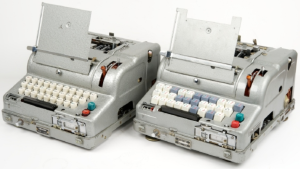
Until the 1950’s the WWII the ECM Mark II was used by the NATO, when it was replaced by machines like the KL-7.
KL-7 was an electro-mechanical rotor-based off-line cipher machine, developed by the National Security Agency (NSA) and was introduced in 1952 and served for many years as the main cipher machine of the US and NATO.
It is basically a more advanced version of the German Enigma machine, but the KL-7 has eight rotors, seven of which are moved in a complex irregular stepping pattern.
The machines came in several variations and were used by the US Army, Navy, NATO and Foreign Affairs for many years.

RACE (Rapid Automatic Cryptographic Equipment) is an off-line cipher machine, developed by Standard Telefon og Kabelfabrik A/S (STK) in Norway in the late 1970s, as one of the successors to the ageing KL-7.
RACE was the first high-end cipher machine were the cryptographic algorithms were purely implemented in software.
The algorithms were stored in PROMs and the machine was constructed in such a way that up to five algorithms plus a test-program could be installed, simply by adding banks of PROMs on one of the machine’s circuit boards.
Each algorithm, or PROGRAM as it was called, could be selected from the 6-position PROGRAM SELECTOR at the front panel.

DERBY was the Norwegian national CEROFF standard, which is similar to but not compatible with EPSOM. Is was probably only released to the Norwegian Armed Forces and national organisations. It supports two cryptografic keys, each of which provides full message protection, with special features for exclusive messages. It was approved by NATO for all levels of classification.
ASCOT is a special program for man-to-machine and machine-to-man communication. It allows the use of One-Time Pads (OTP) or the interoperable pocket size PACE encryptor at the other end. ASCOT was also released to foreign RACE customers.
EDITA was the so-called EDIT ASSISTENT that was developed to help the operator when preparing a punched message tape for ON-LINE transmission. EDITA was also released to foreign users.
Although the KL-51 was developed during the early 1980s, some units were still in use in the late 2000s. In 2006, the US Navy was developing plans to gradually replace the remaining KL-51 units with a more modern device that could be integrated with the latest complex data networks; a possible candidate for this replacement is the KIV-7.

The machine is similar to the American Sigaba, the KL-7 and the Enigma.
The original M-125 was succeeded by the M-125-3 in the mid-1960s and remained in use until the early 1990s.
At the heart of each Fialka machine is a drum with 10 different electromechanical cipher wheels or rotors, that move in an irregular manner when entering a message. Each wheel has 30 contacts at either side and is identified by a letter of the Russian alphabet.
The M-105, codename: AGAT, was a Russian off-line cipher machine that was developed and built in the USSR in the late 1960s. The machines were used by all countries of the Warsaw Pact and the encryption is due by a built-in key tape mixer that was fed with an 11-level punched paper tape with random data.
The M-105 was succeeded by the fully electronic M-205 D in 1986 but many M-105 machines remained in use until the end of the East-Germany. For communication between the East-Germany Government and Hungary, the M-105 was replaced by the T-353 (Dudek) in 1987.
Julian Bolivar-Galeno is an Information and Communications Technologies (ICT) Architect whose expertise is in telecommunications, security and embedded systems. He works in BolivarTech focused on decision making, leadership, management and execution of projects oriented to develop strong security algorithms, Artificial Intelligence (AI) research and its applicability to smart solutions at mobile and embedded technologies, always producing resilient and innovative applications.
Encryption Is Foundational to The Future (Part 4 The Reign of the Electro-Mechanical Cyphers)


No comments:
Post a Comment